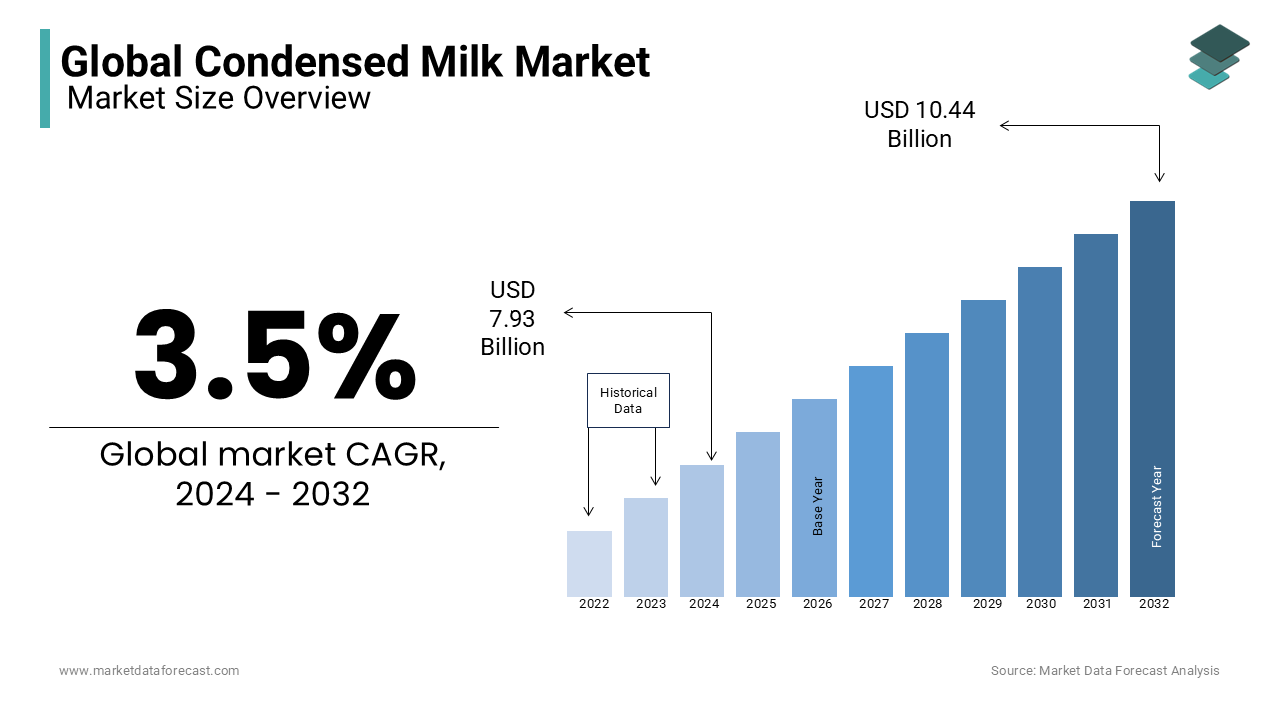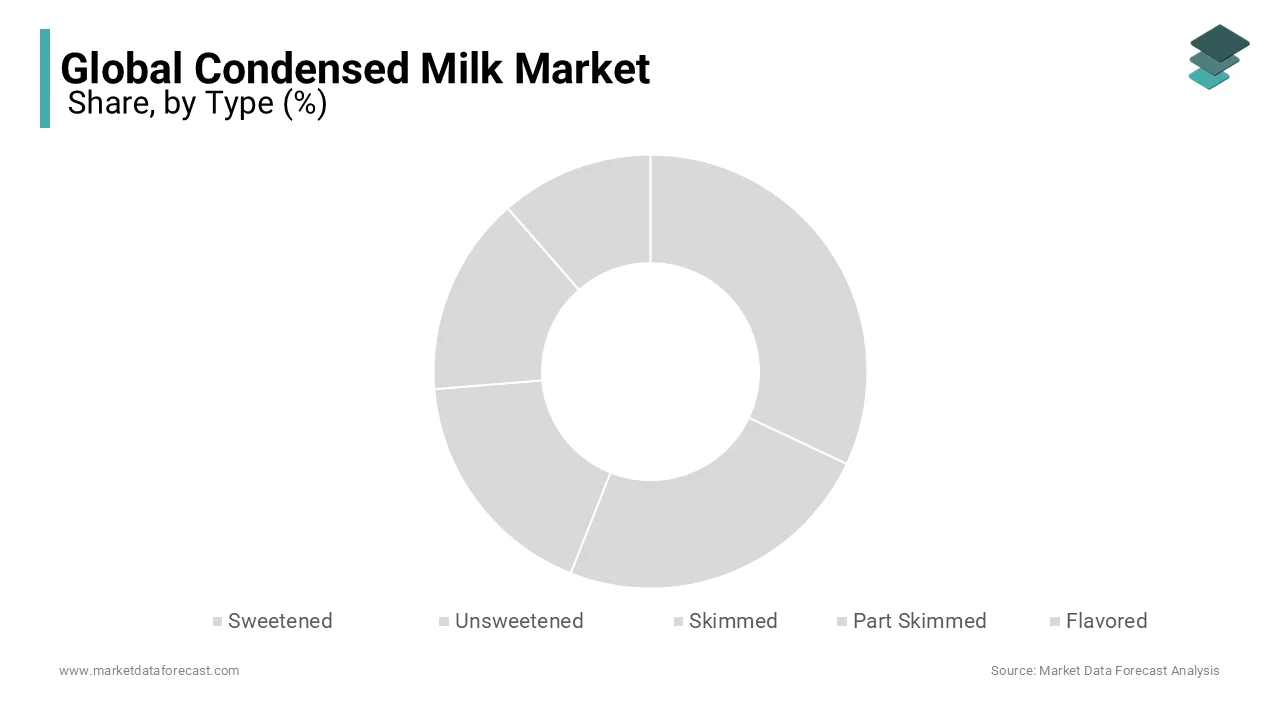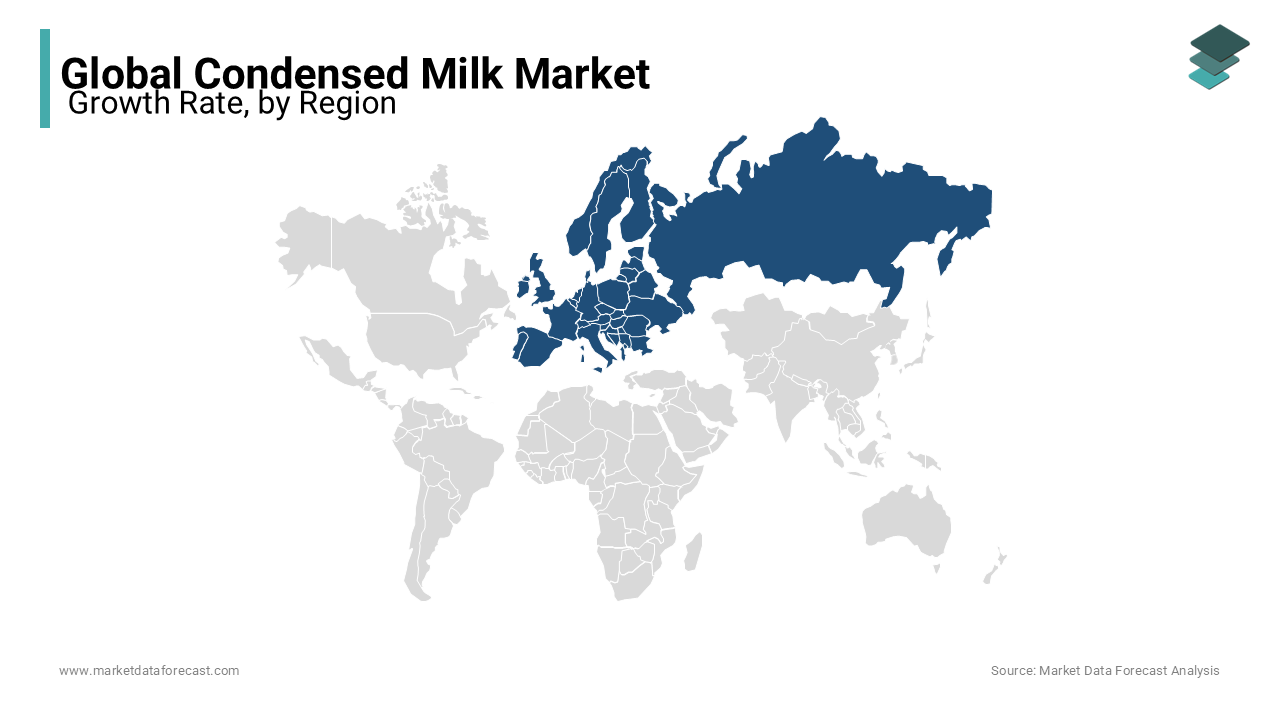Global Condensed Milk Market Size, Share, Trends & Growth Forecast Report By Type (Skimmed, Part Skimmed, Sweetened, Unsweetened and Flavored), Application (Bakery, Confectionary, Foods, Beverages and Personal & Beauty Care), Sales Channel (Departmental Stores, Online Retailing, Supermarkets/Hypermarkets and Retail Shops), And Region (North America, Europe, APAC, Latin America, Middle East And Africa), Industry Analysis (2025 To 2033)
Global Condensed Milk Market Size
The size of the global condensed milk market was valued at USD 7.93 billion in 2024. The global market is expected to be worth USD 8.21 billion in 2025 and USD 10.81 billion by 2033, exhibiting a CAGR of 3.50% from 2025 to 2033. The wide application of condensed milk in desserts and confectionery is likely to lead the market boom in the future.

Condensed milk is basically a form of milk produced by the evaporation of moisture from milk. This ratio removes approximately 60% of the water from the total volume of milk. Condensed milk is rich, thick, and provides the same nutritional benefits. Condensed milk has numerous applications in food, beverage, bakery, and confectionery. The milk evaporation process helps to increase the shelf life of condensed milk. Germany, France, and Switzerland are critical manufacturing points for sweetened condensed milk worldwide. Condensed milk is closely related to the dairy markets, generating notable returns, and is supposed to record steady growth over the forecast period.
MARKET DRIVERS
The global condensed milk market is expected to grow over the forecast period as demand for processed dairy products increases and the confectionery industry grows. Furthermore, the growing demand for culinary products, such as tea, coffee, and desserts, is supposed to accelerate market growth. In addition, concentrated milk is one of the main ingredients in desserts such as cakes and ice cream due to its thick texture and sweet flavor. Therefore, an increase in dessert demand is assumed to have a positive impact on market growth during the prediction period. Quality and longevity are the main consumer preferences and drive the purchase of food and beverages. The long useful life indicates that the consumption of the product has been extended. As a result, consumers tend to buy products in bulk and store them for future use. This purchasing activity is expected to drive the sale of condensed milk. The product lasts for more than a year after the printed expiration date, if opened, for approximately 3 weeks after opening. This is one of the main characteristics of condensed milk, and it is presumed to be the leading product in the market. As awareness spreads through campaigns and social media, there is a growing demand for dairy-free alternatives to all possible foods.
Also, the lactose intolerance group has been buying these products at a very high rate, keeping in mind that desserts can be enjoyed without fear like ordinary people. People with a sustainable mindset also prefer vegan breakfast products and figurative products because they do not guarantee any animal abuse at the time of production. Therefore, due to the multiple benefits of consuming non-dairy products, the vegan concentrated milk market is anticipated to show significant growth in the future. The effect has become evident as vegetable dairy exports increase worldwide. Condensed milk gives the rich dessert a smooth and creamy texture, making the end product tasty and sweet. Similar applications, such as fruit toppings and savory toppings, are expected to increase consumption of the product, thereby promoting market growth over the estimated period. Condensed milk has impressive nutritional value when consumed in the correct amount. This product contains around 60 calories per tablespoon, making it ideal for weight-focused consumers. It also contains essential vitamins and minerals like calcium, potassium, magnesium, and vitamin A that promote bone health. As awareness of the benefits of a product increases, demand for the product is deemed to increase in the coming years. R&D processing of condensed milk by evaporation, drying, and treatment at ultra-high temperatures is envisioned to open the way for the market during the forecast period.
MARKET RESTRAINTS
The demand for mortgage foods can hinder the growth of condensed milk, which is sweetened primarily for use in multipurpose food applications. Furthermore, as the purchasing power of consumers increases, their propensity to consume healthy foods has increased. Growth in the healthy drinks and beverages market is expected to limit the market for the next seven years. Furthermore, the quality of the milk used in production and seasonal fluctuations in sales can have a negative impact on the market.
REPORT COVERAGE
|
REPORT METRIC |
DETAILS |
|
Market Size Available |
2024 to 2033 |
|
Base Year |
2024 |
|
Forecast Period |
2025 to 2033 |
|
CAGR |
3.5% |
|
Segments Covered |
By Type, Application, Sales Channel, And Region |
|
Various Analyses Covered |
Global, Regional & Country Level Analysis, Segment-Level Analysis, DROC, PESTLE Analysis. Porter’s Five Forces Analysis, Competitive Landscape; Analyst Overview of Investment Opportunities |
|
Regions Covered |
North America, Europe, APAC, Latin America, Middle East & Africa |
|
Market Leaders Profiled |
Nestlé S.A., The J.M. Smucker Company, GCMMF PVT LTD, Magnolia Inc., Goya Foods Inc., F&N Foods Pte Ltd, Meijer, Inc., Sun Hing Foods Inc., Meadow Gold Dairies, and Olvebra Industrial |
SEGMENTAL ANALYSIS
By Type Insights

Skimmed condensed milk is attributed to leading the largest share of the market, whereas the unsweetened segment is likely to hold the highest CAGR by the end of the forecast period. The rising importance of storing milk for many months, especially in urban cities, is slightly elevating the growth rate of the skimmed condensed milk market. It is produced by removing all the milk fats from the cow's milk, which is then packaged in a uniform way to extend its lifespan for about one year without opening the seal. Sweetened condensed milk is a sweet product that is very thick and does not require refrigeration. Changes in lifestyle and people's interest in high-quality products are solely responsible for the huge growth rate of the market throughout the forecast period.
By Application Insights
The bakery segment is leading with the largest share of the condensed milk market. The launch of innovative bakery products using condensed milk in accordance with the people's interests is accelerating the segment's growth rate. In urban areas, people depend more on eating bakery items, and the prominence of adding high-quality raw materials substantially elevates the growth rate of the market. The beverages segment is additionally to have the highest CAGR during the forecast period. The use of condensed milk in various beverages adds taste by adding different flavors according to consumers' preferences, which is majorly surging the growth rate of the market. The confectionery segment is set to have great opportunities during the forecast period.
By Sales Channel Insights
The online retailing segment is ascribed to have a prominent share of the market by the end of 2032. There is a growing number of food delivery applications where it is feasible to order a wide range of food products that will be delivered to the doorstep. With busy schedules, people are now more likely to depend on online stores, which are gaining huge traction in the market's growth rate.
The supermarket/hypermarkets segment is attributed to having a steady growth rate during the forecast period. High disposable income in developed and developing countries is one of the common factors that contribute to the growth of the segment. Easy availability of various branded condensed milk in supermarkets in the nearest store is likely to enhance the growth rate of the market to the next level
REGIONAL ANALYSIS
In 2023, Europe dominated only the condensed milk market, with a total share of 38.0%. Most global sales have been driven by Germany and Poland, with improved dairy production in these countries. Additionally, sweetened condensed milk is primarily used in morning beverages such as tea and coffee to reduce the bitter taste of coffee beans and tea leaves. The Asia Pacific region is foreseen to show the fastest growth in the future due to the growth of sweetened condensed milk in Europe and North America. In addition, the increase in the consumption of products in the main countries of Southeast Asia, such as Vietnam and Malaysia, is a determining factor. This product is used in many traditional dishes along with other flavors like coconut and cashew to improve flavor. However, this market is expected to face obstacles due to the high-calorie content of the product and the spread of obesity and heart disease. The demand for condensed milk products for desserts and confectionery is increasing not only in Canada but also in the United States. The main reason for the increase in demand is that consumers can easily handle the condensed milk available in cans, bottles, and tubes, which can be selected according to the needs of the application and quantity. In addition, the market for aroma milk is growing due to the diverse spice demands of the North American population.
KEY MARKET PLAYERS
Major key players in the global condensed milk market are Nestlé S.A., The J.M. Smucker Company, GCMMF PVT LTD, Magnolia Inc., Goya Foods Inc., F&N Foods Pte Ltd, Meijer, Inc., Sun Hing Foods Inc., Meadow Gold Dairies, and Olvebra Industrial.
RECENT HAPPENINGS IN THE MARKET
- Royal FrieslandCampina N.V., The Netherlands, increased Alaskan Milk Corporation's share from 8.1% to 68.9%, while expanding the global market by purchasing $ 5505 million worth of shares in the Uytengsus family.
- With the merger of FarineLactée Henri Nestlé and Anglo-Swiss Milk Company, Nestlé offers baby products and concentrated milk.
- One of the leading market players, Vinamilk, is concentrating on improving the brand's penetration in Southeast Asia due to the high demand for dairy products in those countries. This is expected to lead the entire market in the coming years.
- Fraser &Neave Holdings Bhd (F & NHB) launched Milk Stix and Squeeze Tube, Malaysia's first cream-sweetened condensed milk to boost product sales.
MARKET SEGMENTATION
This research report on the global condensed milk market has been segmented and sub-segmented based on type, application, sales channel, & region.
By Type
- Sweetened
- Unsweetened
- Skimmed
- Part Skimmed
- Flavored
By Application
- Foods
- Beverages
- Bakery
- Confectionary
- Personal & beauty care
By Sales Channel
- Online retailing
- Supermarkets/hypermarkets
- Departmental stores
- Retail shops
By Region
- North America
- Europe
- APAC
- Latin America
- Middle East & Africa
Frequently Asked Questions
1. What are the key factors driving the growth of the condensed milk market?
Factors such as increasing consumer preference for convenient and ready-to-use dairy products, growth in the food and beverage industry, and rising demand for sweetened dairy products are driving the growth of the condensed milk market.
2. What are the packaging trends in the condensed milk market?
The market has shifted towards convenient packaging formats such as squeeze tubes, resealable pouches, and single-serve portions to cater to consumer preferences for on-the-go consumption and portion control.
3. What are the future growth prospects and opportunities in the condensed milk market?
The market is expected to grow due to increasing urbanization, changing consumer lifestyles, and product innovations such as low-fat and organic condensed milk variants. Expansion into emerging markets and diversification of product portfolios are also critical strategies for industry players looking to capitalize on market opportunities.
Related Reports
Access the study in MULTIPLE FORMATS
Purchase options starting from
$ 2500
Didn’t find what you’re looking for?
TALK TO OUR ANALYST TEAM
Need something within your budget?
NO WORRIES! WE GOT YOU COVERED!
Call us on: +1 888 702 9696 (U.S Toll Free)
Write to us: sales@marketdataforecast.com
